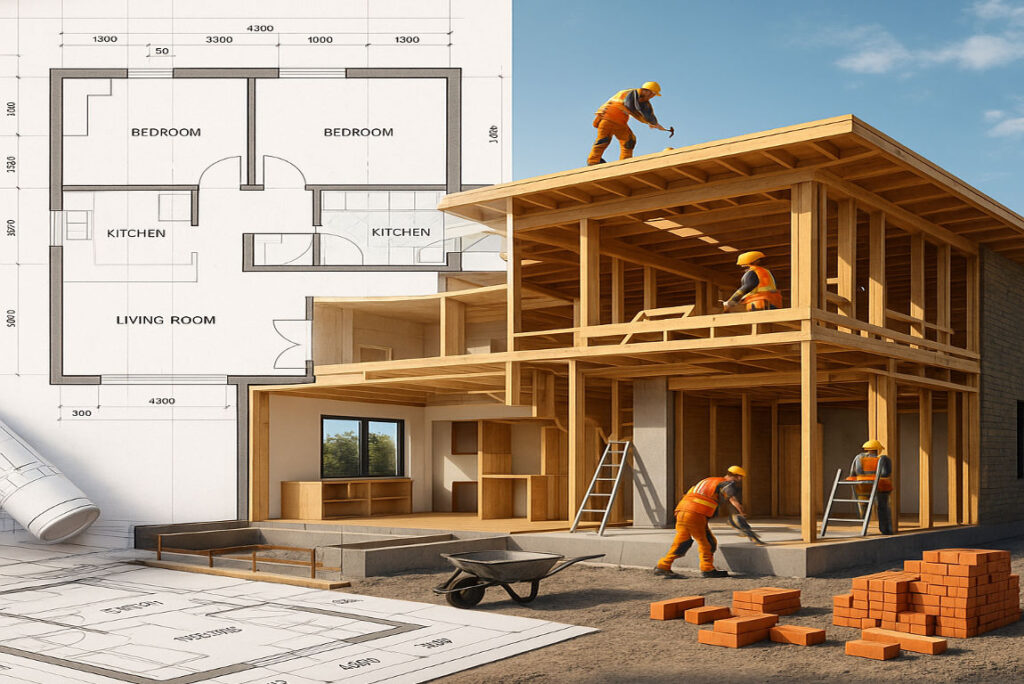Building a 2-bedroom house is an exciting journey that combines creativity, planning, and execution. Whether you’re constructing your dream home or investing in a rental property, understanding the process is crucial. One of the most common questions people ask during this process is: “How many blocks for two rooms?” This question is essential because blocks are the foundation of your house, and estimating them accurately can save you time, money, and effort.
Understanding the Basics of a 2-Bedroom House

Before we get into the nitty-gritty of block calculations, let’s first understand what a typical 2-bedroom house entails.
Typical Layout and Components
A 2-bedroom house generally includes:
- Two bedrooms: These are the primary living spaces for residents.
- Living room: A shared space for relaxation and entertainment.
- Kitchen: The heart of the home, where meals are prepared.
- Bathroom(s): Usually one or two, depending on the design.
- Optional spaces Include a Dining area, storage, or a small porch.
This layout is compact yet functional, making it ideal for small families, couples, or individuals looking for a cozy home.
Average Size and Carpet Area
The size of a 2-bedroom house typically ranges between 650 to 800 square feet. This size provides enough space for comfortable living while keeping construction costs manageable.
Importance of Accurate Planning
Planning is the backbone of any construction project. Before you start building, you need to:
- Finalize your budget.
- Choose a suitable plot.
- Design a floor plan that maximizes space and functionality.
Accurate planning ensures that you avoid costly mistakes and delays during the construction process.
How Many Blocks Are Needed for a 2-Bedroom House?

Now, let’s address the key question: How many blocks are needed for two rooms?
Blocks as a Primary Building Material
You may also read (the impact of closet regulations on florida home design).
Blocks are the most commonly used material for constructing walls. They are durable, affordable, and easy to work with. The number of blocks you’ll need depends on several factors, which we’ll explore below.
Average Number of Blocks Required
On average, a 2-bedroom house requires 2,700 to 3,200 blocks. This estimate varies based on the size of the house, wall height, and design complexity.
Factors Influencing Block Quantity
- Wall Area Calculation
- To estimate the number of blocks, you first need to calculate the total wall area. Use this formula:
- Wall Area = Carpet Area × Wall Height
- For example, if your house has a carpet area of 700 sq ft and a wall height of 10 ft, the total wall area would be 7,000 sq ft.
- Load-Bearing vs. Non-Load-Bearing Walls
- Load-bearing walls require more blocks as they are thicker and stronger. Non-load-bearing walls, on the other hand, use fewer blocks.
- Window and Door Openings
- Subtract the area of windows and doors from the total wall area to avoid overestimating the number of blocks.
Example Calculation
Let’s assume:
- Wall area = 7,000 sq ft
- Block coverage = 13 blocks per square meter
Convert square feet to square meters (1 sq ft = 0.0929 sq m):
7,000 sq ft × 0.0929 = 650 sq m
Now, calculate the number of blocks:
650 sq m × 13 blocks/sq m = 8,450 blocks
This is a rough estimate and may vary based on your specific design.
Estimating Other Essential Materials Alongside Blocks

Blocks are just one part of the equation. You’ll also need other materials to complete your house.
Cement
Cement is essential for laying blocks. For a 2-bedroom house, you’ll need approximately 50 bags of cement.
Sand
Sand is mixed with cement to create mortar. The quantity depends on the block size and the thickness of the mortar joints.
Iron Rods and Reinforcement
Iron rods are used for structural reinforcement, especially in load-bearing walls and foundations.
Contingency for Wastage
Always include a 5-10% contingency for material wastage and breakage. This ensures you don’t run out of materials mid-project.
Step-by-Step Guide: From Vision to Reality
Building a house involves several stages. Here’s a step-by-step guide to help you navigate the process.
Planning and Design
You may also read (how much is a three bedroom house).
- Set Your Budget: Determine how much you’re willing to spend.
- Select a Plot: Choose a location that suits your needs.
- Design the Floor Plan: Collaborate with an architect to create a functional floor plan.
Foundation and Structural Work
- Excavation: Dig the foundation to the required depth.
- Foundation Walls: Use blocks to build the foundation walls.
- Reinforcement: Add iron rods for stability.
Wall Construction Using Blocks
- Laying Blocks: Start from the corners and work inward.
- Openings: Leave spaces for windows and doors.
- Reinforcement: Add lintels above openings for support.
Roofing and Finishing
- Roofing: Select a roofing material that suits your budget and local climate.
- Plastering: Apply plaster to the walls for a smooth finish.
- Painting: Add a splash of color to bring your house to life.
Tips for Optimizing Costs and Materials

- Buy in Bulk: Purchase blocks and other materials in bulk to save money.
- Use Local Suppliers: This reduces transportation costs.
- Minimize Waste: Plan your block usage carefully to avoid wastage.
- Hire Skilled Labor: Experienced workers can complete the job more efficiently and with higher quality.
Common Mistakes to Avoid
- Underestimating Material Quantities: Always calculate materials accurately to ensure a precise estimate.
- Ignoring Structural Integrity: Don’t Compromise on Quality to Save Money.
- Poor Planning: Ensure your floor plan is practical and functional.
- Not Accounting for Wastage: Always include a contingency for breakage and waste.
You may also read (elevate your space bed risers for metal frame houses).

